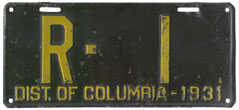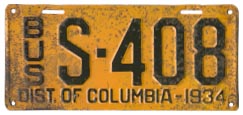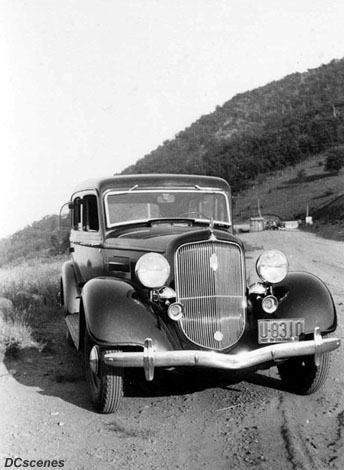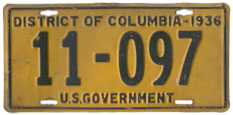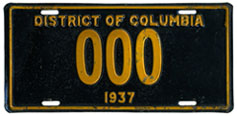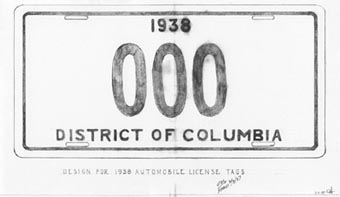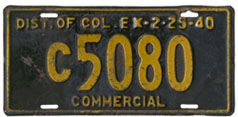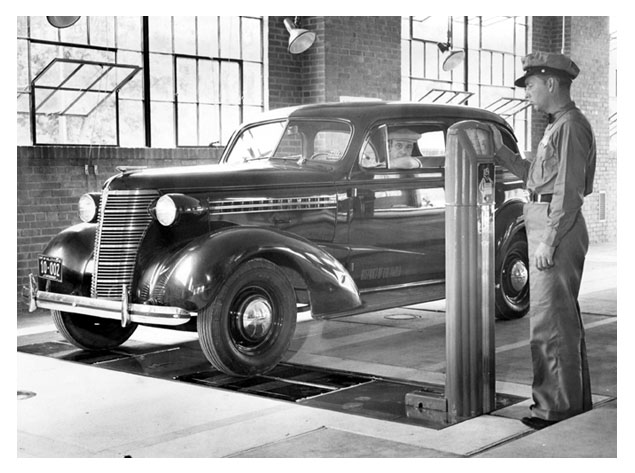License Plates and Registration Numbers
from January 1930 to February 1940
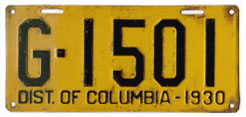 |
1930 |
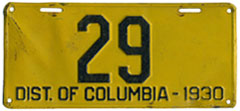 |
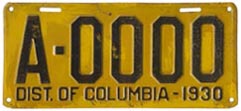 |
Differences in the die used to emboss the year designation on the two plates pictured above suggest that at least two companies may have been involved in the manufacture of 1930 District of Columbia license plates. |
|
|
||||||||||||||||||||||||||||||||||||||||
|
|
|
Passenger. These twelve prefix letters have been observed on 1930 auto plates (in conjunction with the numbering format introduced for 1927 as discussed on a separate page): E, F, G, J, K, M, N, P, U, V, W, and Y. Based upon letter series known to have been used during the three previous years it is reasonable to assume that Z-prefix plates were also used for this year. Furthermore, with the number of plates thought to have been required for 1930 and in light of the existence of T-series plates for the following year, we have also assumed that the T series was available (and was presumably used) this year. If these assumptions were found to be true there would be 14 passenger letter series for 1930. As indicated in our section about 1927-1934 plate numbering referenced above, the quantity of available all-number plates for 1930 increased to 9,999 (from 1,000 in 1929). Including the 9,999 plates without a letter prefix (numbers 1 through 9999) and assuming there were 14 different passenger plate letter prefixes, there were 149,985 possible passenger registration number combinations for 1930. Non-Passenger. Refer to the 1927-1934 Registration Numbers section for information about to which non-passenger types plates with prefix letters A, B, C, D, H, L, R, and X were assigned. |
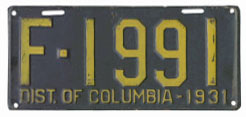 |
1931 |
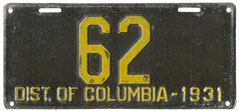 |
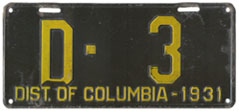 |
|
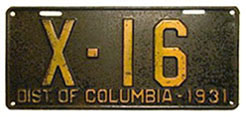 |
The first agency to administer the registration of motor vehicles in the District of Columbia, the Automobile Board, was formed in May 1903. A July 1950 Evening Star article in which one long-serving employee's tenure at the Dept. of Vehicles and Traffic is discussed indicates that “The present office was created by Congress in 1931, and she joined the staff under W.A. Van Duzer.” The “present office” referenced is believed to be the Dept. of Vehicles |
and Traffic, which is known to have been in existence by 1933, and Mr. Van Duzer was likely its first director. The same article indicates that "Since 1932 the Van Duzer automobile has carried number 13. When Mr. Van Duzer died, Mrs. Van Duzer asked for the number.” It was also in 1931 that the city's vehicle title law went into effect. |
|
|
||||||||||||||||||||||||||||||||||||||||
|
|
|
Passenger. These 15 prefix letters have been observed on 1931 auto plates (in conjunction with the numbering format introduced for 1927 as discussed on a separate page): E, F, G, J, K, M, N, P, S, T, U, V, W, Y, and Z. If it is assumed that 15 prefix letters were used on passenger plates this year and including the 9,999 plates without a letter prefix (numbers 1 through 9999), there are a total of 159,984 possible passenger registration number combinations. Non-Passenger. Refer to the 1927-1934 Registration Numbers section for information about to which non-passenger types plates with prefix letters A, B, C, D, H, L, R, and X were assigned. As discussed above, observed 1931 truck plate number 2B-700 shows that a type designation letter can be in the second position. |
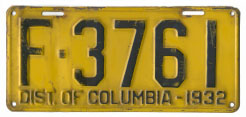 |
1932 |
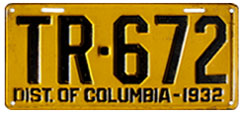 |
 |
|
|
||||||||||||||||||||||||||||||||||||||||
|
|
|
Passenger. These 12 prefix letters have been observed on 1932 auto plates (in conjunction with the numbering format introduced for 1927 as discussed on a separate page): E, F, G, J, K, M, P, S, T, U, V, and W. Based upon letter series known to have been used since 1927 it is reasonable to assume that N-, Y-, and Z-prefix plates were also used for this year, and if this were found to be true there would be 15 passenger letter series for 1932. If it is assumed that 15 prefix letters were used on passenger plates this year and including the 9,999 plates without a letter prefix (numbers 1 through 9999), there are a total of 159,984 possible passenger registration number combinations. Non-Passenger. Refer to the 1927-1934 Registration Numbers section for information about to which non-passenger types plates with prefix letters A, B, C, D, H, L, R, and X were assigned. . |
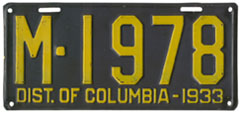 |
1933 |
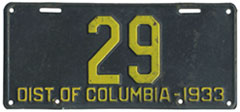 |
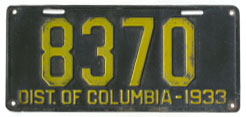 |
|
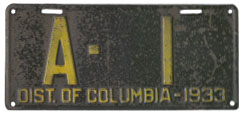 |
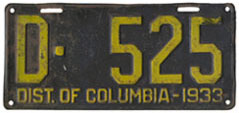 |
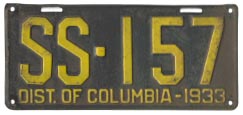 |
|
|
||||||||||||||||||||||||||||||||||||||||
|
|
|
Passenger. These 11 prefix letters have been observed on 1933 auto plates (in conjunction with the numbering format introduced for 1927 as discussed on a separate page): E, F, G, J, K, M, N, T, V, W, and X. Based upon letter series known to have been used since 1927 it is reasonable to assume that P-, U-, Y-, and Z-prefix plates were also used for this year, and if this were found to be true there would be 15 passenger letter series for 1933. If it is assumed that 15 prefix letters were used on passenger plates this year and including the 9,999 plates without a letter prefix (numbers 1 through 9999), there are a total of 159,984 possible passenger registration number combinations. Note that X has been added to the list of letters thought to have been used on regular passenger car plates. This change has been made based upon the observation of 1933 plate number X-3629, a number that seems far too high to have been needed for the Non-Resident classification, to which the letter X is thought to have been assigned in 1927. Most states in which Non-Resident (and similar types such as Guest and Visitor) plates had been issued in the 1910s and 1920s had abandoned the type by the mid 1930s, so it is reasonable to assume that it had outlived its usefulness in Washington, D.C., too. Non-Passenger. Refer to the 1927-1934 Registration Numbers section for information about to which non-passenger types plates with prefix letters A, B, C, D, H, L, and R were assigned. |
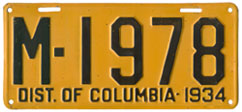 |
1934 |
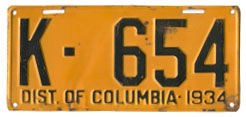 |
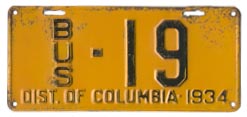 |
|
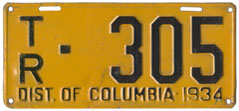 |
|
|
||||||||||||||||||||||||||||||||||||||||
|
|
|
Passenger. These 12 prefix letters have been observed on 1934 auto plates (in conjunction with the numbering format introduced for 1927 as discussed on a separate page): E, G, J, K, M, N, P, T, U, V, W, and X. Based upon letter series known to have been used since 1927 it is reasonable to assume that F-, Y-, and Z-prefix plates were also used for this year, and if this were found to be true there would be 14 passenger letter series for 1934. If it is assumed that 15 prefix letters were used on passenger plates this year and including the 9,999 plates without a letter prefix (numbers 1 through 9999), there are a total of 159,984 possible passenger registration number combinations. Non-Passenger. Refer to the 1927-1934 Registration Numbers section for information about to which non-passenger types plates with prefix letters A, B, C, D, H, L, and R were assigned. |
|
||||||||||||||||
Although definitive information about this subject is unknown, based upon surviving examples we may reasonably conclude that the numbering system employed on Washington, D.C. license plates was unchanged, at least in its basic structure, from 1935 (plates dated "1935") through the end of the 1947 registration year (at March 31, 1948, at which time plates marked "EX-3-31-47 that were validated with a metal tab marked "48" were in use). Specific blocks of numbers (as discussed below) set aside for display on plates of various types may have changed during this 13-year period, but the manner in which numbers were used presumably was consistent. In short, we must begin this dicussion with an overall statement to the effect that the numbering of 1935-47 D.C. plates is not completely understood. What appears to have occurred during this period is that the lowest numbers, 1 through 9999, were set aside for issuance to owners of private passenger vehicles. The next group of numbers, 10-000 through some unknown five-digit number (although not the same number throughout the period) was broken into smaller groups and used for most non-passenger registrations. Then, private passenger registrations picked up at some point and continued to be issued as high as necessary. |
||||||||||||||||
|
|
|||||||||||||||
Throughout this period registration numbers associated with privately-owned passenger cars were assigned from two sequences: plates with up to four digits are numbered from 1 through 9999, and higher numbers are known with both five- and six-digit serials. Specifically as to these five- and six-digit numbers, the lowest and highest number known of each plate is presented in this table:
Naturally, higher numbers were reached on plates used for more than a twelve-month period. This data (nor other extant information) does not allow us to conclude at which point on plates of each year the numbering of non-passenger plates ceased and passenger plates commenced (the "cutoff point"). Taking 1936 as an example, we know of sightseeing bus plate no. 52-070 and passenger plate no. 54-623, whereas for 1937 we know the cutoff point was lower due to the existence of dealer plate no. 42-101 and passenger plate no. 46-702. This assumes, of course, that numbers were not duplicated on plates of various types (including passenger), which seems a fairly safe assumption. |
So few non-passenger plates issued from 1935 through early 1948 are known that it is impossible to determine, based on existing examples, which blocks of numbers were set aside for the various registration types. In general, however, we can conclude that many types were evidenced by plates numbered from 10-000 through some undetermined five-digit number. There are, however, exceptions. Commercial (truck) plates of this era were originally numbered as most other types, but based upon the existence of 1937 truck plate no. 42-101 and a plate of the same type for the following year numbered B1754 we have concluded that letter prefixes were reintroduced on plates of (probably only) this type in 1938, probably due to the quantity of registrations and the desire to again indicate the registration class on the plate. (Truck plates were designated by weight-class letter prefixes prior to 1935.) Other non-passenger types did not utilize five-number plates, most notably Motorcycle and Diplomatic. This table provides a summary of known five-number 1937-47 non-passenger plates:
|
|||||||||||||||
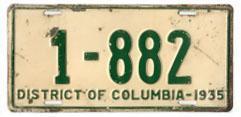 |
1935 |
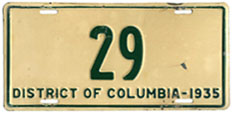 |
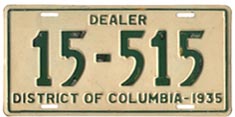 |
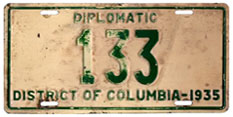 |
Although in this space we once indicated that 1935 plates may have been to first to be produced at Lorton Reformatory rather than by a private contractor, an early 1934 memo in which the production of 1935 plates is discussed indicates that this is not the case. “The dies from which our automobile plates are made are so badly worn that it will become necessary this year to replace them,” wrote W.A. Van Duzer, Director of Vehicles and Traffic, leading us to conclude that annual plates of the design introduced in 1928 were likely all made at Lorton. New dies used to produce 1935 plates were designed to resemble those then used by two of the states. “These figures have been found by experience in New York and Pennsylvania to be practical from a visibility standpoint,” wrote Mr. Van Duzer. Indeed, D.C. 1935 registration number characters closely resemble those then in use in New York since 1930, and to a lesser extent Pennsylvania dies introduced on that state's 1934 plates. The Feb. 1934 memo quoted twice above also recommends “that the color scheme for next year be lawn green figures on a white background.” The several changes and provisions specified in the memo had already been approved by the city traffic council and the superintendent of police by the time it was approved by the commissioners on Feb. 20, 1934. The numbering system used since 1927 that included letter prefixes (in most cases) to designate the registration type was abandoned for 1935 in favor of a system, not yet fully understood, in which certain blocks of numbers were set aside for the various types (as discussed above). Mr. Van Duzer explained the change in his memo to the commissioners: “It has been found by experience that there is considerable confusion caused by a multiplicity of low numbers combined with letters, and that it is desirable from a police standpoint to have as few duplications of numbers as possible. The only duplication of numbers recommended is in the diplomatic and motorcycle series.” In fact, Mr. Van Duzer should have also mentioned private passenger car plates, for plates of all three types were numbered beginning at 1. The lowest all-number plates appear to have been more formally considered reserved in 1935 compared to previous years, as discussed on our Reserved Passenger plates page. |
|
|
||||||||||||||||||||||||||||||||||||
|
|
|
Passenger. Refer to the text above for an overview of registration numbers used from Jan. 1935-March 1948. Specifically with respect to 1935, the lowest (five-digit) and highest observed numbers are 57-943 and 190-377. |
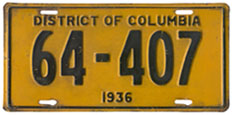 |
1936 |
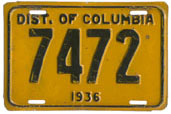 |
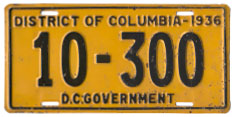 |
|
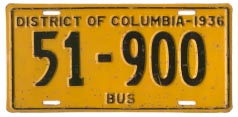 |
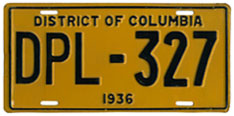 |
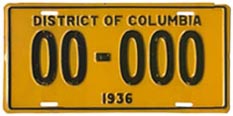 |
Most noteworthy about 1936 is that this is the first year for which plates with a number comprised of fewer than than five digits were made on a smaller plate than those with five or six characters. This practice continued through the 1947 registration year. The 1936 color scheme was determined in March 1935. Director of Vehicles and Traffic W.A. Van Duzer wrote this to Commissioner Melvin C. Hazen on the subject: “For 1936 Virginia license tags will be a black background with white figures, and 1936 Maryland tags will be a blue background with white figures. It would be impractical for us to reverse our tags for next year -- that is, green background with white figures, as there would be a possibility of confusion. I have had different [1936 test] tags made up, and [superintendent of police] Major Brown and I have looked them over under lights and find that chrome yellow background with black figures is the best contrast. It is recommended that these colors be selected for our1936 tags.” In fact, 1936 Virginia plates wound up being painted orange on dark blue, and Maryland plates of that year are white on black. |
|
|
||||||||||||||||||||||||||||||||||||||||||||
|
|
|
Passenger. Refer to the text above for an overview of registration numbers used from Jan. 1935-March 1948. Specifically with respect to 1936, the lowest (five-digit) and highest observed numbers are 54-623 and 201-965.
|
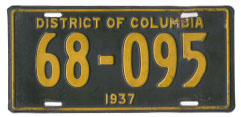 |
1937 |
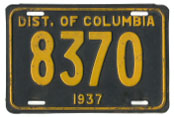 |
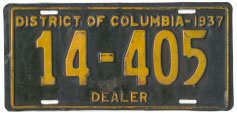 |
|
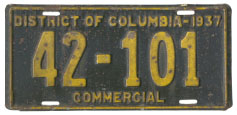 |
|
|
Receipt by the Dept. of Vehicles and Traffic of the first batch of 1937 license plates was announced by Director William A. Van Duzer on Tue., Sept. 15, 1936. In an Evening Star article, Mr. Van Duzer warned vehicle owners to begin preparing for the year-end renewal season by satisfying their outstanding traffic violation obligations because registrations could not be renewed if there were unpaid tickets. "My advice is to come in now and settle up and save a lot of trouble later on, when the rush begins and long lines are waiting at the license tag windows," said the director. The Sept. 15 Evening Star article indicates that 1937 registration renewal applications were to have been printed by Oct. 19 and mailed between Oct. 26 and Nov. 14. On Nov. 16 the first batch of 1937 plates was scheduled to be mailed to motorists, although they were not available for purchase at the Dept. of Vehicles and Traffic until Nov. 30. The earliest display date was Dec. 15, and of course the use of new 1937 plates was required as of midnight on Dec. 31, when 1936 plates became obsolete. |
|
|
||||||||||||||||||||||||||||||||||||||||||||
|
|
|
Passenger. Refer to the text above for an overview of registration numbers used from Jan. 1935-March 1948. Specifically with respect to 1937, the lowest (five-digit) and highest observed numbers are 46-702 and 193-024.
|
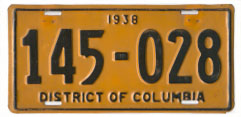 |
1938 |
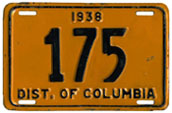 |
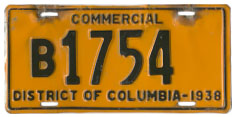 |
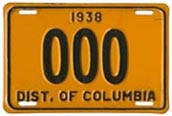 |
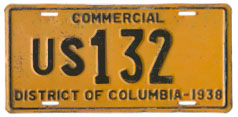 |
|
|
||||||||||||||||||||||||||||||||||||||||||||
This pencil sketch of the proposed 1938 license plate design was drawn on Feb. 2, 1937; approved and initialed by Director of Vehicles and Traffic W.A. Van Duzer the following day; and accepted by the commissioners on February 5. |
|
|
|
Passenger. Refer to the text above for an overview of registration numbers used from Jan. 1935-March 1948. Specifically with respect to 1938, the lowest (five-digit) and highest observed numbers are 50-724 and 181-626.
|
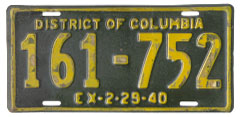 |
1939 Jan. 1, 1939- |
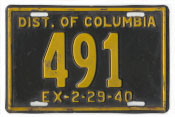 |
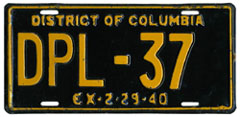 |
|
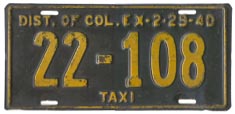 |
Thought to be the only U.S. license plate to be embossed with a leap year expiration date, this feature was necessary due to a change in the registration year from the calendar year to a March 1-Feb. 28 (or 29) period. Details about the change, and similar changes that occurred in future years (all of which confuse plate collectors today) may be found by clicking here. There is no Washington, D.C. license plate with the year designation "1939." |
|
|
||||||||||||||||||||||||||||||||||||||||||||||||
|
|
|
Passenger. Refer to the text above for an overview of registration numbers used from Jan. 1935-March 1948. Specifically with respect to 1939, the lowest (five-digit) and highest observed numbers are 50-808 and 173-778.
|
|
This page last updated on December 31, 2017 |
 |
|
copyright 2006-2018 Eastern Seaboard Press Information and images on this Web site may not be copied or reproduced in any manner without consent of the owner. For information, send an e-mail to admin@DCplates.net |














